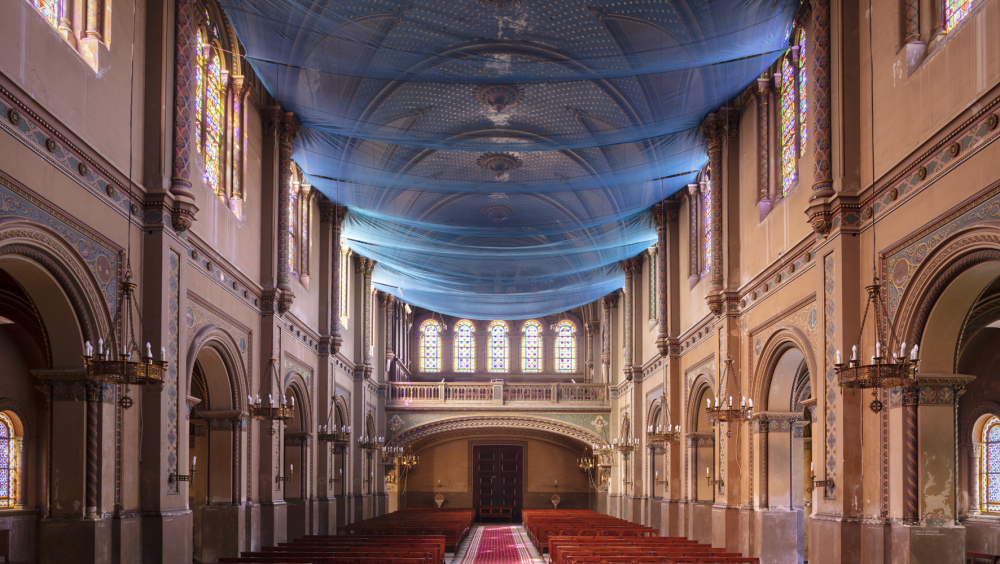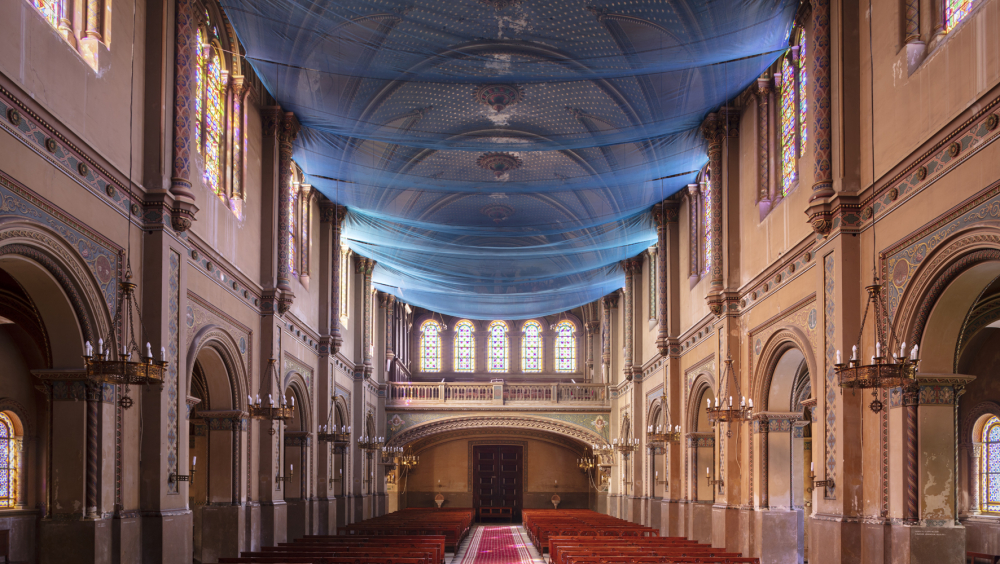A través de la música y la luz. Recursos didácticos para todas las personas (Through music and light. Teaching resources for everyone)
The project of the "Iglesia Jesuitas Valencia" is a work of community. It is not only the restoration of the old chapel of the San José de Valencia school but it is a set of actions where the artisans and professionals involved in the restoration process are the protagonists. Artisans and crafts. It is a work that is done in phases, little by little, dedicating the time they deserve and those periods serve to become a work open to citizens.
In each phase of restoration, various actions have been programmed that help to disseminate the restoration: neighbors, schoolchildren and cultural managers visits, professional talks on the interventions in the mural paintings, experimental excavation in the phase of pavements and radiant floor, invitations to illustrious alumni and audiovisual record of collective memory ... And with these actions, specific material has been created that remain in the building as support to tell its story. All this makes the chapel the perfect background to develop synergies between citizens and professionals, between new technologies and crafts, between different cultures and generations, in short, it becomes a generator of heritage communities.
In this 2023 the intervention phase is special. It focuses on two elements that, not being "massically architectural", give it the majesty for which a religious building like this stands out: the stained glass and the centenary organ. In other words, light and music.
Light and music are part of an intangible heritage that is rarely so linked to tangible heritage. This period of work will allow us to enjoy it and share it by creating innovative didactic projects that will reformulate the visits to a heritage building in the XXI century. We move away from information panels for visitors.
Our commitment of dissemination is inclusive, where all people (and autonomously) can know the operating mechanisms of an pipe-organ or understand the work process to build the stained glass.
Two didactic resources at the service of citizens that, with the help of workshops and exhibition performances scheduled throughout the year, will provide greater knowledge of the religious heritage open to society.
International synergies for heritage didactics.
In the last decades of the XIX century the construction of the chapel of the old school of San José de Valencia begins. Its neo-Byzantine style, and its construction system, make this building a remarkable example of religious architecture throughout the region.
With the passage of time it has undergone numerous modifications, introducing at all times new technical and aesthetic solutions, resulting in a work of great complexity. The presence of important pathologies has led to the drafting of a global action project, considering the possibility of being executed in phases.
Among the elements to highlight we find its Palop organ (the organ builder Pedro Palop married the French master organ builder Albert Randeynes’ daughter, with whom he trained) relevant artisan throughout the Spanish territory for the quality of pipe organ execution at the beginning of the XX century. In addition, the organ of the Valencia Jesuit Church was one of the last examples that survived the Spanish Civil War (saved from burning), which celebrates 102 years. It has a german console and 788 tubes (wood, zinc and tin) and this year it is being restored by Fréderic Desmottes, organ builder (Certificate of Professional Aptitude).
Another element to highlight are its stained glass windows, our building has the largest area of stained glass windows in the entire Valencian Community. The restoration of the glass windows is being a very enriching process both for the technical team, for the property and especially for all the citizens who come to know more about the history and the creation and restoration process of the large colored panels.
In addition to the restoration work, in recent months a new life cycle has been launched for the church. This heritage asset, traditionally for private use, adapts to the new times with an integrative, community and social vocation, becoming a headlight space for multicultural events for the citizenship. Because times change, it is enough to look at these last two years to analyze how society has evolved, the ways of life, of relating and, why not, the way we use buildings.
Religious monuments mark the history of our peoples, they are examples of splendor in the past, but they have also been centers of welcome and refuge. In the XXI century, many of them continue having a social mission and a conciliatory engine of cultures. There are numerous examples of exemplary adapted buildings, collecting the new guidelines for the management of heritage assets and the recommendations for the conservation of religious property. And at the same time they continue to serve disadvantaged groups. The case of the old San José school’s chapel in Valencia (Iglesia Jesuitas Valencia), is a clear example of the new practices of social and cultural management.
A global project aims to revalue heritage by showcasing the historical-artistics values, but also social, spiritual and cultural ones involving property, technicians, administrations and above all society (Faro Convention, 2005).
Expository language has been characterized primarily by basic assets (the object and its associated explanatory literature) that are not very inclusive. That is, the interpretive panels used throughout the XX century for the patrimonial object (in that case the organ and the stained glass windows of the Jesuit Church Valencia) are obsolete with respect to the current dissemination guidelines. In the XXI century, visitors and tourists bring different visions and cultures (and different languages of communication), they are people with disabilities (blind or limit vision, who need adapted texts), and with unequal social realities (visitors with illiteracy or learning disabilities) ... These realities that must be included in our dissemination work require innovative and creative ways of teaching. Culture at the service of all in an inclusive and autonomous way.
These objectives imposed by the heritage didactics team of the Iglesia Jesuitas Valencia harmonize with the guidelines of the European Heritage Days and other actions around the dissemination of community heritage:
−the construction of a responsible citizen identity (personal, social and cultural) based on the respect and preserve the environment and the past
−the development of critical social thinking, to be able to historically situate the evidence of the past and create social, political and cultural meaning
-the building of European links and relations, by international school exchanges to develop a common project around cultural heritage, and
−the ability to get involved and act responsibly in the conservation, preservation and dissemination of the local and global environment
We create tools to participate in the visit, sensations, emotions, knowledge and experiences. Thinking and feeling hold the key to understanding how things work, how they hold themselves, why light is reflected or a metal tube makes that sound... so there is the moment when the environment makes us remember, evoke or imagine in the mind past experiences, linked to common sensations. So to complement the information and create new ways of seeing, listening and connecting with our past and history.
We developed two principal tools this year to disseminate these restoration works, placing the crafts and intangible heritage at the center.
The detachable pipe-organ of high quality pieces made by our colleagues from the Netherlands OrgelKids project, winners of the Religious Heritage Innovator of the Year award. The acquisition of this tool will place Iglesia Jesuitas Valencia as a reference center in terms of music: concerts (which are already being performed), concerts with the restored organ and from now on, training for schoolchildren, adults and of course making agreements with music conservatories. The pipe-organ is a beautiful instrument with a lot of things to discover. Of course there is organ music in all kinds of styles. But the technique with which the sound is made is also very interesting for children. And let’s not forget the history of the organ as part of cultural heritage. The meaning and function of organs at different times provides a fascinating insight into part of cultural history.
Tangible resources to recognize the glassmaker craft will be developed by a heritage didactics team, adapting the themes to the public, and vice versa. On this occasion, light tables will be built. Presented vertically, the original stained glass windows and some reproductions serve as support for the discourse that unfolds horizontally on the horizontal reading. The game is invited to the educational space with a fun and familiar activity. In this immersive and intimate place, wake up with stained glass windows through experimentation. Puzzles, memory and other famous board games are repurposed to facilitate learning. In the midst of the stained glass windows exposed at eye level, fun mixes with discovery.
Since the beginning (XII century), the technique of stained glass we can affirm that the School of France has highlighted and, later, towards the XIV century, this works emerged in Germany. The stylistic diffusion of the stained glass window is produced thanks to the realization of international projects of the most outstanding schools. The cathedral of Chartres or the Saint Chapelle in France or the cathedral of Cologne are the most outstanding examples of this technique that were exported and reached other places in Europe. This is the case of the school of Valencia and the Prats stained glass workshops; the most important that existed in Valencia at that time, in charge of making the stained glass windows for the Palace of the Regional Exhibition of 1909.José Muria, who signs the stained glass windows of the Jesuit Church Valencia, was trained in the valencian school.
On the other hand, the fact that the pipe organ of the Jesuit Church is influenced by the French school through the master organ builder Albert Randeynes, and currently restored by Fréderic Desmottes, gives us the opportunity to present the presents restoration and dissemination works beyond Spain and create synergies with the French pipe organ collective (and its dissemination centers).
Pipe organs, commonly found in churches, have long been considered individual musical objects. Germany is the country that has the most organs, with 40,000 organs for liturgies. But in terms of didactics and dissemination of this music, the Netherlands have stood out in recent years. Synergies between all these countries can be generated with the development of this educational program.
It is a material heritage, consisting of organs and stained glass windows as sound and light monuments, but on the other hand of an intangible heritage common throughout Europe.

